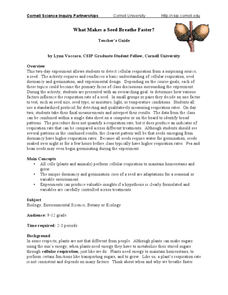Curated OER
Early Scientists' Contributions
Five scientists and their contributions to modern cell theory are listed, one person per slide. It concludes by having viewers answer recap questions. This simple presentation can be used on the first day of your unit on cells to...
Curated OER
WET Science Lesson #5: Pass the Salt Please! (How Road Salt Affects Wetlands)
As an anticipatory set, biologists listen to the story of Ruth Patrick, a scientist who used algae to detect water quality. They observe a demonstration of osmosis and diffusion. In their lab groups, they place Elodea stalks in...
Teach Engineering
Cellular Respiration and Bioremediation
You can breathe easily now that you've found a winning resource. Young biologists learn about the process of cellular respiration, primarily through teacher-led discussion and instruction. They also consider the concept of...
Curated OER
Extracting DNA from Your Cells
Three steps are needed to extract DNA from learners' inner cheek cells. The procedure and reasons for each step are explained. As enzymes work on the cells, a series of questions are answered regarding the structure of the DNA molecule....
Curated OER
Structure and Function of the Cell/Introduction to the Cell
So, this is not technically a worksheet, but rather a chapter of reading material, pictures, and diagrams introducing young biologists to the cell. Cell theory, diversity, size, and shape are described. The internal organization and...
Curated OER
Stem Cell Development
Like a fresh canvas, stem cells can turn into almost anything. In a comprehensive lesson, high school biologists use clay to build a 3-D model of cell division and the processes that occur during the first 14 days of development. Also...
National Center for Case Study Teaching in Science
Cell Phone Use and Cancer
The cell phone you're using is making you deaf: news at 11:00. Oftentimes, the media uses fear tactics and other techniques to increase its audience base. In an intriguing look at the difference between scientific journals and...
Grapevine Colleyville Independent School District
Mitosis Claymation Lab Instructions and Rubric
A single-paged set of instructions and grading system for a mitosis project are laid out for your life science learners. (Note that the page is repeated, making this a two-page document.) Pairs of beginning biologists use clay to model...
Howard Hughes Medical Institute
The Making of the Fittest: Natural Selection in Humans
Sickle cell disease only occurs when both parents contribute the trait, and mostly in those of African descent. Where did it come from? How did it evolve? Tony Allison, a molecular biologist, noticed a connection between sickle cell and...
Curated OER
The Chemicals of Living Cells
Designed to be a study guide or self assessment for high school biologists, the worksheet has good questions about cell chemistry, but would need to be reformatted if you want your kids to write their answers on the paper. There are also...
Serendip
How Do Biological Organisms Use Energy?
When an organism eats, how does food become energy? Young biologists follow glucose through the process of cellular respiration to the creation of ADP using a discussion-based activity. The resource also highlights conservation of mass...
Curated OER
Cellular Transport and the Cell Cycle
With a multitude of questions, this worksheet offers learners the opportunity to review their knowledge about the cell cycle. Question types include true/false, word bank, and completing a table about the differences between interphase...
Curated OER
Meiosis Starts With?
How do you fill in the blanks about meiosis? With this handout! Most of the blanks have a letter filled in to give learners a hint. This resource is a good way for young biologists to ensure they have learned all the necessary vocabulary...
Curated OER
Protists - The Protozoans
Five pages provide thorough coverage of three protozoans: euglena, amoebae, and paramecia. For each, junior biologists read factual text, label the organism, and write answers to several questions. This neatly organized assignment is...
Curated OER
Chapter Seven: Cell People and More Notes
Who were the key players in cell theory? Use a handout to help young biologists record the basics about cell theorists and cell types. It refers to chapter seven of a textbook, but does not include the name of the textbook.
Curated OER
The Case of Regulation in Cells
After your biologists have learned about transcription, translation, and gene regulation, they work in a small group to create a poster of a system that serves as an analogy of the gene regulation process. They share their creations with...
Curated OER
How Do Cells Reproduce?
Beginning biologists prepare a sugar solution for yeast cells to live in, and divide it into two different jars. Samples from each jar are viewed with a microscope, and then one jar is placed in a warm environment and the other a cold...
Curated OER
The Nervous System: Basic Organization and Function
A vintage learning exercise on the basic structure and function of the nervous system awaits your beginning biologists. Although it pertains to a textbook chapter reading, the content is relevant to any introductory unit on the nervous...
Curated OER
What Makes a Seed Breathe Faster?
Here's a five-star lesson plan in which inquisitors conduct sophisticated experimentation with cellular respiration in plant seeds. Placing seeds in a closed system they measure the amount carbon dioxide produced and relate it to...
Baylor College
Observing Different Microbes
Following directions from a colorful slide preparation card, beginning biologists examine three different live microorganisms: bacteria, yeast, and paramecia. This is not an unusual activity to do with your class, but if you are doing it...
Curated OER
AP: Chapter 45: Chemical Regulation & Communication - Hormones and the Endocrine System
Infuse your AP biologists with the details of the endocrine system. This six-page worksheet queries learners thoroughly about gland structure and hormone function. Ms. Foglia, the author, has not left anything out of this resource,...
Curated OER
Reviewing Mitosis/Mitosis
There are technically two presentations in this collection of slides. The first presentation is a single-slide comparison of plant cell division and animal cell division. The second focuses on the steps of meiosis and the genetic...
Curated OER
Early Scientists
Expose your beginning biologists to the development of cell theory and the scientists who played significant roles. The slides do not present much detail, and there are no teachers' notes to guide your lecture. Review the slides as an...
Curated OER
AP: Chapter 26: Origin of Life
Five pages take biologists on a generalized survey of the origin of life. Queries are made regarding theories of how life developed, ancient Earth conditions, and the ever-changing field of taxonomy. The experiments of different...

























